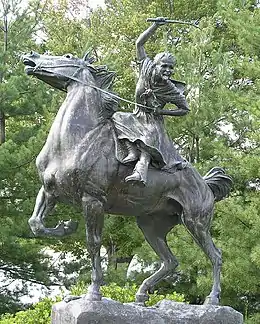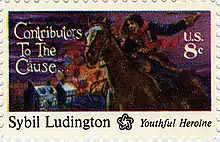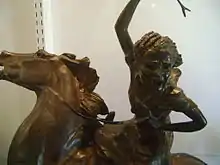Sybil Ludington
Sybil Ludington (April 5, 1761 – February 26, 1839) was a heroine of the American Revolutionary War. On April 26, 1777, at age 16, she made an all-night horseback ride to alert militia forces in the towns of Putnam County, New York, and Danbury, Connecticut, of the approach of British forces.
Sybil Ludington | |
|---|---|
 | |
| Born | April 5, 1761 |
| Died | February 26, 1839 (aged 77) |
| Spouse(s) | Edmond Ogden (m. 1784) |

Her story was first published in 1880 by local historian Martha Lamb, to whom it was probably told by Ludington's descendants.[1][2][3] Her book has the earliest known reference to Ludington's ride. A later reference appeared in an account of her father's life published in 1907.[4] Because of the lack of contemporary accounts, one prominent historian has questioned whether these events occurred.[5]
Contemporaneous sources suggest that the patriot army and the town of Danbury, Connecticut, were already aware of the approaching British troops, as noted in The New-York Gazette and the Weekly Mercury, May 19, 1777,[6] which stated, "On Saturday, the 26th of April, express came to Danbury from Brigadier General Silliman, advising that a large body of enemy had landed the day before at sun set, at Compo, a point of land between Fairfield, and Norwalk, and were marching toward Danbury. Measures were immediately taken." But Ludington was the daughter of a Westchester County, New York, militia colonel who needed to rally the hundreds of local troops under his command and needed time to plan the battle yet to come, so either she volunteered to warn the surrounding towns and rally the troops, or she carried out the task at her father's direction.
Ludington has been widely celebrated since around 1900. Memorial statues honor her, and books have been written about her. She was honored on a United States Bicentennial postage stamp that was released on March 25, 1975, which depicts her on her horse, Star.
Childhood
Sybil was born in Fredericksburg, New York, which is now called Ludingtonville. She was the first of 12 children.[7] Her parents were Abigail Knowles and Henry Ludington, who were first cousins. The family moved to a large farm in Dutchess County, New York, where Sybil Ludington's siblings were born.
Ludington's ride
On April 26, 1777, Sybil Ludington rode her horse, Star, 40 miles (64 km) through the night in Putnam County, New York, to warn approximately 400 militiamen under her father's command that British troops were planning to raid Danbury,[8] where the Continental Army had a supply depot. On her way to gather her father's troops, she warned people asleep in their homes by banging on their shutters with a stick and yelling "The British are burning Danbury!"[9]
Sybil's father had fought in the French and Indian War, and he volunteered to head the local militia during the Revolutionary War. Sybil had to move from town to town following her father, and unknowingly played an important role in the success of the American colonies in their revolution. During the raid, the supplies of the Continental Army were burned, although casualties were low on both sides, thanks in part to the actions of Ludington. Little was told of Ludington's ride; the only record of this event was written by her great-grandson and her father’s memoirs which were published in 1907 but written 100 years earlier on page 90. Her ride started at 9 p.m. and ended around dawn mostly along present day route 6, route 52 and route 32.[7]
Prior to her famous ride, Sybil saved her father from capture. A Loyalist named Ichobod Prosser and 50 other Loyalists tried to capture her father, but Sybil lit candles around the house and organized her siblings to march in front of the windows in military fashion, to give the Loyalist the impression that troops were guarding the house. The Loyalists fled.[10]
She rode a total of 40 miles (64 km)[11] in the hours of darkness, through Carmel, New York on to Mahopac, then to Kent Cliffs and Farmers Mills, and finally back home. She used a stick to prod her horse and knock on doors. She returned home soaked with rain and exhausted, but most of the 400 soldiers were ready to march.[12] The American militia arrived too late to save Danbury, but they were able to drive General William Tryon and his men to Long Island Sound.[12] Ludington was congratulated for her heroism by friends and neighbors and also by General George Washington.[lower-alpha 1][13][14][15][16][17][18][19][20]


Ludington married Edmond Ogden in 1784 when she was 23, and they had a son named Henry. Edmond was a farmer and innkeeper, according to various reports. In 1792, the family settled in Catskill. Ogden died in 1799, and in 1811 Ludington moved to Unadilla, New York, where she lived until her death on February 26, 1839 at the age of 77. She was buried near her father in the Patterson Presbyterian Cemetery in Patterson, New York.[7] Her tombstone shows a different spelling of her first name.
Questionable history
Ludington was first written and published about in an 1880 book about the New York City area by local historian Martha Lamb. However, Sybil’s father's; Colonel Henry Ludington does state in his memoirs on page 90 asking her to ride the countryside to alert the Militia. This primary account had to be written prior to his death in 1817. She relied on numerous primary sources, including letters, sermons, genealogical compilations, wills, and court records to document Ludington's life.[21] She did not, however, provide documentation of the ride, and there are no known written references to it prior to her book.
Historian Paula Hunt has provided a detailed history of the Ludington story and how it has been presented in the media. She does not pronounce on whether the story is accurate. She does state that many popular details were "fictions", such as the horse named Star, the stick in her hand, and the 40-mile distance.[22] Hunt writes:
Sybil's ride embraces the mythical meanings and values expressed in the country's founding. As an individual, she represents Americans' persistent need to find and create heroes who embody prevalent attitudes and beliefs.[23]
In 1996, the national Daughters of the American Revolution said that the evidence was not strong enough to support their criteria for a war heroine, and they removed a book about her from their headquarters bookstore. The DAR chapter near her historic home says that her exploit was documented, and it continues to honor her. Paula Hunt concludes, "The story of the lone, teenage girl riding for freedom, it seems, is simply too good not to be believed."[24]
Legacy and honors
In 1935, New York State erected a number of historic markers along Ludington's route. A commemorative statue sculpted by Anna Hyatt Huntington was erected near Carmel, New York, in 1961. Smaller versions of the statue were erected on the grounds of the Daughters of the American Revolution headquarters in Washington, D.C., on the grounds of the public library in Danbury, Connecticut, and in the Elliot and Rosemary Offner museum at Brookgreen Gardens, Murrells Inlet, South Carolina.[25] In 1975, Ludington was honored with a postage stamp in the "Contributors to the Cause" United States Bicentennial series.[7]
The Sybil Ludington 50k Run has been held in Carmel, New York each April since 1979, a 50-kilometre (31 mi) foot race. The course of the race approximates her historic ride, and finishes near her statue on the shore of Lake Gleneida, Carmel.[26] In 1993, composer Ludmila Ulehla wrote the chamber opera Sybil of the American Revolution based on the story of Ludington's ride.[27] In 2014, Sybil Ludington was featured on the American Heroes Channel documentary American Revolution: Patriots Rising. 2010 a movie was made about her called “Sybil Ludington, The female Paul Revere”. https://m.imdb.com/title/tt1645934/ . The following reference 1978 book by Webster’s she is noted and a lot of military heroes are left out as to be included is an honor of exclusiveness “Ludington, Sybil,” McHenry, Robert (Edited by); “Webster’s American Military Biographies” Dover Press, NY: 1978
Notes
- In spite of these many repetitive citations, at least one prominent modern historian has raised doubt in a scholarly journal that the ride even ever took place, let alone its embellishments of a personal visit by Washington, or a trumping of he and Rochambeau.[5]
References
- Paula D. Hunt, "Sybil Ludington, the Female Paul Revere", New England Quarterly, vol. 88, No. 2, p. 190
- Martha Joanna Lamb; Mrs. Burton Harrison (1880). History of the City of New York: The century of national independence, closing in 1880, vol. 2. A. S. Barnes. pp. 159–60, vi.
- Magazine of Western History. 1893. p. 479.
- Fletcher Johnson, Willis (1907). Colonel Henry Ludington: A Memoir.
- Hunt, Paula D. (June 2015). "Sybil Ludington, the Female Paul Revere: The Making of a Revolutionary War Heroine". The New England Quarterly. 88 (2): 187–222. doi:10.1162/TNEQ_a_00452. ISSN 0028-4866. S2CID 57569643.
- The New-York Gazette and the Weekly Mercury, May 19, 1777
- Profile, Historic Patterson website; accessed February 23, 2015.
- Lisa Tendrich Frank (2013). An Encyclopedia of American Women at War: From the Home Front to the Battlefields, Volume 1. ABC-CLIO. p. 365. ISBN 9781598844436.
- Lisa Tendrich Frank (2013). An Encyclopedia of American Women at War: From the Home Front to the Battlefields, Volume 1. ABC-CLIO. p. 365. ISBN 9781598844436.
- Porath, Jason (2016). Rejected Princesses. Dey St. p. 19. ISBN 9780062405371.
- Kwong, Jess. "17 Women Who Made History — That You've Never Heard Of". www.refinery29.com. Retrieved November 21, 2019.
- Sybil Ludington: a Revolutionary Hero, traverseforwomen.com; accessed February 23, 2015.
- Sybil Ludington article by Jone Johnson Lewis, Women's History
- Sybil Ludington – Her Midnight Ride, lindseywilliams.org; accessed February 23, 2015.
- Miller, p. 18, "Later, America's general George Washington came to Sybil's house to thank her."
- Moore, p. 300, "Afterward, General George Washington made a personal visit to Ludington's Mills to thank Sybil for her courageous deed."
- Macmillan/McGraw-Hill, "Biography – Sybil Ludington 1761–1839", Unit 3, Chapter 5, The American Revolution "Later, Sybil was thanked personally by General George Washington".
- Binkley, p. 18, "Afterward, General George Washington made a personal visit to Ludington's Mill to thank Sybil for her courageous deed."
- Smithsonian Source – Confirmation Readings (Sybil Ludington)
- Weatherford, p. 31, "... After the battle at Danbury, George Washington and French General Rochambeau came to the Ludington home personally, to thank Sybil."
- Lamb (1896). History of the City of New York. A.S. Barnes. pp. v–vi.
- Paula D. Hunt, "Sybil Ludington, the Female Paul Revere", The New England Quarterly, vol. 88, No. 2, p. 207.
- Paula D. Hunt, "Sybil Ludington, the Female Paul Revere: The Making of a Revolutionary War Heroine." New England Quarterly (2015) 88#2 pp. 187–222, quote p. 187 online
- Hunt, pp. 213, 217–18, quote on p. 222.
- Willicox, Kathleen (2014). "Sybil Ludington: NY's Lesser-known (Teenage, Female) Paul Revere". New York Makers Magazine. Retrieved May 17, 2017.
- Sweeney, Bob; McCurtin, Ellen. "Sybil Ludington 50k". Sybil Ludington 50k Run. Bob Sweeney, & Ellen McCurtin. Retrieved July 4, 2016.
- "Sybil Ludington". Encyclopedia of World Biography. Gale. July 8, 2016. Retrieved June 15, 2017.
27. ^. “Ludington, Sybil,” McHenry, Robert (Edited by); “Webster’s American Military Biographies” Dover Press, NY: 1978
Sources
- Binkley, Marilyn R., Reading Literacy in the U.S.: Findings from the IEA Reading Literacy Study, DIANE Publishing, 1996, ISBN 0-7881-4512-6
- Black, Virginia Morrow, Gallop To Glory, Brockagh Books, 2017 ISBN 9781530913244
- Bohrer, Melissa Lukeman, Glory, Passion, and Principle: The Story of Eight Remarkable Women at the Core of the American Revolution, Simon and Schuster, 2003, ISBN 0-7434-5330-1
- Hunt, Paula D., "Sybil Ludington, the Female Paul Revere: The Making of a Revolutionary War Heroine," New England Quarterly 88 (June 2015), 187–222.
- Johnson, Willis Fletcher (1907). Colonel Henry Ludington: A Memoir. L.E. and C.H. Ludington (original from Harvard University). ISBN 978-0548540381.
- Miller, Brandon Marie, Growing Up in Revolution and the New Nation, 1775 to 1800, Lerner Publications, 2003, ISBN 0-8225-0078-7
- Moore, David W., Developing Readers and Writers in the Content Areas K-12, Pearson/Allyn and Bacon, 2006,ISBN 0-205-49474-9
- Weatherford, D., Milestones : A Chronology of American Women's History. New York: Facts on File, 1997, ISBN 0-8160-3200-9
See also
External links
| Wikimedia Commons has media related to Sybil Ludington. |
- Sybil Ludington at HistoricPatterson.org
- Michals, Debra. "Sybil Ludington". National Women's History Museum. 2017.